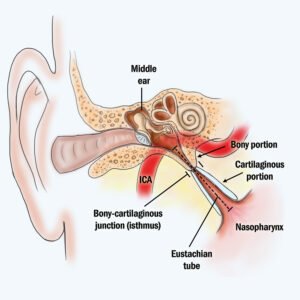
The Eustachian tube and its functions
The Eustachian tube is a narrow tube, and is approximately 43mm in length in adults and extends from the middle ear to the upper part of the throat behind the noise. Also know as the auditory tube, it helps keep the middle ear healthy by equalizing pressure. It also serves as a drain clearing mucus and protecting from pathogens that may cause infections. The eustachian tube consists of bone, cartilage and fibrous tissue. The tube is hallow and lined with cilia (tiny hairs) that sweep mucus away from the middle ear towards the nasopharynx. The Eustachian tube is normally closed but opens when yawing and swallowing. When air pressure changes outside, your eustachian tube opens to allow air to move from the ear canal to the middle ear so the pressure can equalize on both sides of the eardrum. The eustachian tube needs to be free of fluid and debris to properly function.
What causes Eustachian tube dysfunction
Eustachian tube dysfunction (ETD) occurs when the tubes don’t open or close properly. When there is a blockage, it causes unequal pressure in the canal and middle ear. The eustachian tubes most commonly become blocked because of nasal secretions from the cold (upper respiratory track infection), sinusitis or allergies. These secretions may also contain viruses or bacteria which can cause a middle ear infection also know as otitis media. The eardrum becomes tense and does not vibrate so well when hit with sound waves, this results in dulled hearing. Infections may also cause the lining of the eustachian tube to become inflamed and swollen. Allergies like hay fever can create extra mucus and inflammation. Also altitude changes such as flying and hiking can cause problems or aggravate existing inflammation. People who smoke are at an increased risk, as smoking damages the cilia that sweep mucus away from the middle ear towards the throat.
Symptoms of Eustachian tube dysfunction
Symptoms of ETD may include, dulled hearing, a feeling of pressure or fullness. Pain, due to the eardrum being tense and stretched. As it improves, its common to hear a popping noise. Symptoms may last from a few hours to several weeks.
Eustachian tube treatment
Symptoms usually go away without any treatment. Some simple strategies to help relieve Eustachian tube dysfunction include swallowing, yawning or chewing gum. These encourage the swallow reflex. A nasal decongestant can help reduce the swelling of the lining of the tubes. Antihistamine or steroid nasal spray to reduce any allergic reaction. Valsalva maneuver, this is simply pinching your nose, closing your mouth, take a breath and gently pop your ears. This will push air into the middle ear. If these treatments don’t provide any relief, contact your doctor as a referral may be needed for ENT.
